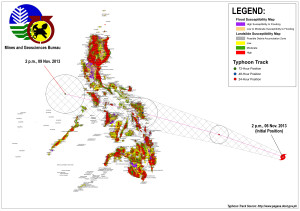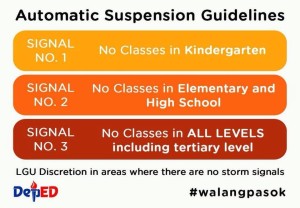Online Resources: Typhoon Yolanda
For updates on Typhoon Yolanda visit the feature page on the Official Gazette website. The page contains a Google Crisis Map in partnership with Google Philippines, including a cowdsourced map of evacuation centers, crisis areas, and relief drop zone areas in relation to Typhoon Haiyan/Yolanda. PCDSPO is working with Google to ensure Philippine government data is provided in a timely manner.
Unified Hashtags:
#YolandaPH
#rescuePh for those needing rescue. This hashtag will be monitored by volunteers who will consolidate reports; the consolidated reports are submitted by PCDSPO to NDRRMC.
#reliefPH for aid and relief efforts. This hashtag will be monitored by DSWD.
#floodsPH to report floods to media, fellow citizens, and the authorities.
How to make sense of flood alerts:
Under the heavy rainfall warning system, a yellow warning is raised when the expected rainfall amount is between 7.5 mm to 15 mm within one hour and likely to continue.
Communities given this advisory are advised to be aware of the weather condition and warned that flooding may be possible in low-lying areas.
The orange alert is raised in areas where rainfall is between 15 mm to 30 mm within one hour. Flooding is a definite threat in communities under the green alert.
A red alert is issued when downpours constitute an emergency. This is raised when observed rainfall is more than 30 mm within one hour or if rainfall has continued for the past three hours and is more than 65 mm.
When Pagasa raises a Red warning, communities should be prepared to respond. It means serious flooding is seen and that residents should be ready to evacuate to safety.
How it works:
Based on the alert level, find out if your area is affected. For example, if you live in Marikina, go to Project Noah. The real time flood reference for Marikina can be seen if you click flood maps and go to flood inundation. PAGASA generate flood scenario for Marikina river every 10 min.
In cases of alerts, it’s the LGU in charge:
MMDA Flood Control – 882-4177, 882-0925
Parañaque DPOS – 829-2056
Manila Traffic Hotline – 527-3087
Cainta Traffic Hotline – 646-0044, 655-7368 loc. 164
Las Piñas Traffic – 874-5756, 874-3957, 874-3927
Mandaluyong Hotline – 534-2993
Taguig Traffic – 838-4301 loc. 7112
Marikina STOC – 646-1651
Pasig Traffic – 643-0000, 724-5813
Makati Public Safety Dept – 844-3146, 819-3270
all LGUs have identified evacuation areas to be used in case of flooding. These are the Bgy. Multi-purpose ctrs., selected bgy. halls, and public schools- Elementary and H.S.
#walangpasok class/work suspension announcements
Twitter accounts to follow:
Official Gazette: the official portal of the Republic of the Philippines. Tweets consolidated updates and information. Follow @govph
PCDSPO: Tweets #WalangPasok advisories from schools and institutions, other advisories. Follow @pcdspo Also see Department of Education@DepEd_PH
NDRRMC: Tweets links to the regular consolidated reports on damage/activities, including rescue/relief/rehabilitation. Requests that appear on the #RescuePH are consolidated and vetted by volunteers who then submit the list to PCDSPO which liasons with NDRRMC to include online requests in the list of those who need rescue. Follow @NDRRMC_Open
PAGASA: For weather forecasts and advisories follow @dost_pagasa
DSWD: Updates on the prepositioning, organization, distribution, of relief and other assistance; also monitors the #ReliefPH hashtag to help coordinate/consolidate releif efforts. Follow @dswdserves
Armed Forces of the Philippines: Follow @TeamAFP
MMDA: For traffic, #FloodsPH advisories, follow @MMDA
Philippine Coast Guard: advisories on sea travel. Follow @PhilCoastGuard1
Department of Transportation and Communications: Advisories on flight cancellations. Follow @DOTCPhilippines
Civil Aviation Authority of the Philippines: Advisories on airport operations. Follow @CAAP_Operations
National Grid Corporation: For advisories on electricity supply follow @ngcp_alert see also Department of Energy: @doe_ph
Localized information:
For localized #YolandaPH advisories:
Office of Civil Defense CALABARZON Region: @ocd_calabarzon
Bacolod City: @BacolodSmiles
Cebu Province: @cebugovph
Philippine Information Agency Bohol Province: @PIABohol
Websites to bookmark:
www.gov.ph : Official Gazette of the Republic of the Philippines
www.noah.dost.gov.ph :Project NOAH (Nationwide Operational Assessment of Hazards)
www.pagasa.dost.gov.ph : The Weather Bureau of the Philippine Government
www.ndrrmc.gov.ph : National Disaster Risk Reduction and Management Council of the Philippines
www.mmda.gov.ph : Metropolitan Manila Development Authority
www.dswd.gov.ph : Department of Social Welfare and Development
www.mgb.gov.ph : Mines and Geosciences Bureau of the Department of Environment and Natural Resources, in particular, Geohazard Maps

List of TyphoonYolandaAffectedBarangays (prospective)
www.piacaraga.com : Philippine Information Agency in the CARAGA Region
Important numbers:
See Emergency Hotlines: also, LGU directory
Philippine National Police (PNP) Hotline Patrol
117 or send TXT PNP to 2920
Bureau of Fire Protection (NCR)
(02) 729-5166, (02) 410-6319
Department of Transportation and Communications (DOTC) hotline
7890 or (02) 726-6255
Department of Public Works and Highways (DPWH)
(02) 304-3713 or (02) 304-3904
Red Cross hotline
143, (02) 527-0000, or (02) 527-8385 to 95
Philippine Coast Guard
(02) 527-3877, (02) 527-8481, 0917-724-3682, 0917-PCG-DOTC, (02) 912-3046, (02) 911-1873
North Luzon Expressway (NLEx) hotlines
(02) 3-5000 and (02) 580-8910
Subic-Clark-Tarlac Expressway (SCTEx) hotlines
(0920) 96-SCTEX (72839) or (02) 459-0522
Skyway System Hotline
(02) 776-7777, 0915-6256231, 0939-5006910
South Luzon Expressway (SLEx) hotline
0917-6877539, (049) 508-7509, or (02) 584-4389
For complete list of hotlines: http://www.gov.ph/emergency-hotlines/
Briefers
Government Informayion during natural disasters
Philippine Area of Responsibility
PAGASA’s Public Storm Signal Warnings
How to Make Sense of PAGASA Color-Coded Warning Signals
Mga Paalala Ukol sa Storm Surge

